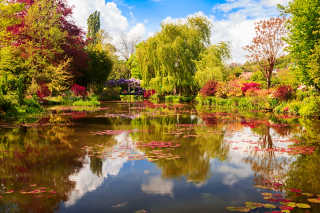Real life destinations of famous paintings
Have you ever stood in front of a painting so vivid that you feel like a part of it? If so, it’s probably because the artist was inspired by a real life setting, somewhere they knew well. While many places and landmarks from famous paintings have been changed beyond recognition, there are still some destinations around the world that the artist would recognize. We’ve rounded up 6 real-life destinations of famous paintings that you can visit.
Claude Monet: The series “Water Lilies”
Giverny, France
At the end of the 19th century, Claude Monet created a beautiful garden at his house in Giverny, near Paris. Although Monet traveled and painted extensively in England and France, this garden was his passion and the water lilies that grew there became his most famous motif. Monet was an important member of the Impressionist school. Impressionism was about trying to recreate what the artist saw in different light and weather conditions. To create his impressive garden scenes, Monet used bold colors and loose brushwork. See his ‘Water Lilies’ at museums as diverse as the National Gallery in London, the Musee d’Orsay in Paris and the Metropolitan Museum of Art in New York, and then visit Giverny. You will be impressed by the care with which Monet blended his painting and gardening skills

Vincent van Gogh: “Coffee at night”
Arles, France
During his short and ultimately tragic life, Dutch artist Vincent van Gogh was denied both fame and fortune. “Le Café la Nuit” was painted in 1888 (just two years before Van Gogh took his own life) and fits into the Post-Impressionist period of art. It depicts the terrace of a busy café in front of a starry night and manages to contrast the dark shadows of the surrounding houses with the brightness that the artificial lighting of the café casts on the cobblestones of the street. Van Gogh’s last years were the most productive of his life with a recent move from Paris to Arles giving him new inspiration. The restaurant, on the Place du Forum, is still there and you can still dine on the terrace. If you want to compare your dining experience with the original painting, you’ll find it at the Kröller-Mϋller Museum in Otterlo, the Netherlands.
Katsushika Hokusai: “Thirty-six Views of Mount Fuji”
Sagami Province, Kanagawa, Japan
Although not well known in the West, Katsushika Hokusai is one of Japan’s most famous landscape painters. Working in the early 19th century, Hokusai was a member of the Nichiren Buddhist sect, a sect that worshiped Mount Fuji as a symbol of eternal life. In homage to the mountain, Hokusai created a work known as “Thirty-six Views of Mount Fuji.” The series is widely exhibited around the world and is currently on view at the MOA Museum of Art, Atami, Japan. There are many places in Sagami province where you can admire the original inspiration of the paintings. One is the popular resort island of Enoshima at the mouth of the Katase River.

Pierre-Auguste Renoir: “Bal du Moulin de la Galette”
Montmartre, Paris, France
Hilly Montmartre is synonymous with art. For centuries, artists have been painting on its streets capturing both local landmarks and local characters. One of the most famous monuments is the Moulin (or windmill) de la Galette, located in Paris, France. The site has long been popular as a venue for parties and dances. With his “Bal du Moulin de la Galette”, painted by the sun in 1877, Renoir vividly captures the festive spirit. It is considered one of the best examples of the Impressionist movement. Admire the original painting at the Musée d’Orsay, and then get back in the festive spirit by dining at Le Moulin De La Galette restaurant in the shadow of the windmill.

Grant Wood: “The American Gothic House”
Eldon, Iowa, United States
While you may not recognize the artist or the painting, you may feel a glimmer of familiarity with the subject. Wood’s painting of a farmer and his daughter has inspired everything from ad campaigns to cartoons to magazine covers. Grant Wood studied art in Europe during the 1920s before returning to his hometown of Eldon. The house was built in the Carpenter Gothic style in the early 1880s by Catherine and Charles Dibble. Carpenter Gothic was an architectural movement that saw traditional Gothic design elements grafted onto frame houses. The figures in front of “The American Gothic House” represent typical small-town Americans of the time. The painting can be seen at the Art Institute of Chicago, while the house is now a museum known as the American Gothic House Center.
Édouard Manet: “The Grand Canal of Venice (Blue Venice)”
Venice Italy
A contemporary and compatriot of Monet, Édouard Manet fell in love with Venice when he visited it in 1875, shortly after the Franco-Prussian War. His “Venice Grand Canal (Blue Venice)” is an impressionistic recreation of the city’s most iconic waterway. With his bold shade of blue and sweeping brushstrokes, Manet successfully captures the bustle and dynamism of the Venetian canals. While the waters of modern Venice may not be as blue as Manet described them, you can still capture the essence of his work with a gondola ride through Venice’s architectural wonders. You will find the original painting in the Shelburne Museum, Vermont, USA.

Do you want to visit other real life destinations based on famous paintings that you can actually visit? Recommendations include “Willy Lott House” (John Constable) in Suffolk, England, “Lake McArthur” (James MacDonald) in British Columbia, Canada, “Chalk Cliffs on Rügen” (Caspar David Friedrich) on the island of Rügen, Germany, and “View of the Colosseum” (Giovanni Paolo Panini) in Rome.

